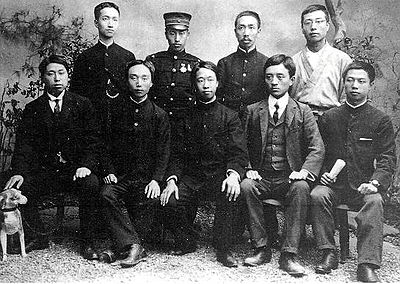- Huaxinghui
-
Not to be confused with Revive China Society.
 Huaxinghui leaders. Photo shot in 1905 in Tokyo。First row left: Huang Xing, fourth from left: Song Jiaoren
Huaxinghui leaders. Photo shot in 1905 in Tokyo。First row left: Huang Xing, fourth from left: Song Jiaoren
The Huaxinghui (Chinese: 華興會; pinyin: Huáxīng Huì; Wade–Giles: Hua-hsing hui), translated as the China Revival Society or China Arise Society, was founded by Huang Xing and Zhang Shizhao on February 15, 1904, in Hunan for the explicit goal of overthrowing the Manchu dynasty. Many of its members later became key figures of the Tongmenghui. The Huaxinghui was dominated by students from Hunan who had returned from Japan. Nevertheless from the very beginning it had strong ties with secret societies, especially with the Ko-Lao Hui whose organizational structure the Huaxinghui paralleled, particularly in the field of the military chain of command. This connects to the primary goal of the Huaxinghui: to "kick out the Tartars" through assassinations of important Manchu officials.
After two failed plots, in November 1904 and early 1905, Huang Xing fled to Japan. There he met Sun Yat-sen in the summer of 1905 for the first time in Tokyo, in order to discuss the possibility of the merger of Sun's Xingzhonghui and the Huaxinghui. A compromise was reached, and Huang decided to support Sun fully. At this point the Huaxinghui had ceased to exist. On August 20, 1905, Sun Yat-sen was elected Tsung-li (premier) of the new party named Tongmenghui. Today historians generally agree that without the Huaxinghui's participation, the founding of the Tongmenghui would not have been possible.[1]
Citations
References
- Chün-tu, Hsüeh (1961). Huang Hsing and the Chinese Revolution. Stanford, California.
- Pak-wah Leung, Edwin (1992). Historical dictionary of revolutionary China, 1839-1976. Greenwood Press. ISBN 0-313-26457-0.
Categories:- History of the Republic of China
- 1904 establishments
- Chinese history stubs
Wikimedia Foundation. 2010.
